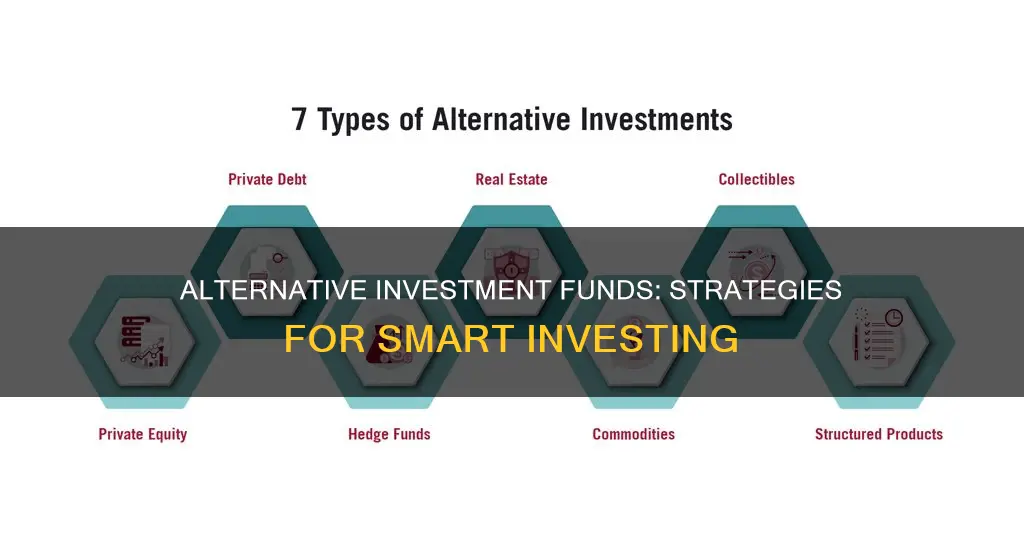
Alternative Investment Funds (AIFs) are a unique type of investment that differs from traditional investment instruments. They are privately pooled funds that require significant investments, so institutions and high-net-worth individuals (HNIs) generally invest in AIFs. AIFs are regulated by the Securities and Exchange Board of India (SEBI) and are divided into three categories based on investment strategies and requirements.
Before investing in AIFs, there are several factors to consider, including investment objectives, track record, management team, fees and expenses, liquidity, risk profile, regulatory framework, and exit options. AIFs typically carry higher risks and require a higher minimum investment compared to traditional investments.
To invest in AIFs, individuals must provide proof of income, a PAN card, and ID proof. Only certain categories of investors, such as Qualified Institutional Buyers (QIBs), High Net Worth Individuals (HNIs), and family offices, are eligible to invest in AIFs according to SEBI regulations.
Overall, AIFs offer a broader range of investment opportunities and alternative asset management methods, making them a valuable addition to a well-diversified investment portfolio.
| Characteristics | Values |
|---|---|
| Definition | A unique type of investment that is distinct from traditional investment instruments. |
| Types | Venture Capital Funds, Infrastructure Funds, Social Venture Funds, Private Equity Funds, Private Investment in Public Equity Funds, Hedge Funds, Real Estate Funds, Debt Funds, Commodity Funds, Private Investment in Public Equity (PIPE) |
| Who can invest? | Qualified Institutional Buyers (QIBs), High Net Worth Individuals (HNIs), Family Offices, Employees and Directors of the AIF |
| Investment Objective | Investors should evaluate the investment objective of the AIF to ensure it aligns with their goals and risk appetite. |
| Track Record | Investors should review the performance of the AIF over time and evaluate its track record. |
| Management Team | Investors should evaluate the experience and track record of the management team before investing. |
| Fees and Expenses | AIFs typically charge management fees and performance fees. |
| Liquidity | AIFs are typically illiquid investments, meaning investors may be unable to sell their investments immediately. |
| Risk Profile | AIFs typically carry higher risks than traditional investments. |
| Regulatory Framework | AIFs are regulated by the Securities and Exchange Board of India (SEBI). |
| Minimum Investment | The minimum investment for an individual is set at Rs. 1 Cr. or Rs. 25 lakhs for an employee, manager, or director of AIF. |
What You'll Learn

Understanding the different types of AIFs
Alternative Investment Funds (AIFs) are a special category of investment that differs from conventional investment instruments. They are privately pooled funds that generally require substantial investments, making them more accessible to institutions and high-net-worth individuals (HNIs). AIFs are regulated by the Securities and Exchange Board of India (SEBI) and are categorised into three broad types based on their investment strategies and requirements. Here is an overview of each category:
Category I AIFs:
These funds focus on investing in startups, early-stage ventures, small and medium-sized enterprises (SMEs), and other sectors deemed socially or economically desirable by the government or regulators. Examples include infrastructure funds, venture capital funds, and social venture funds. Category I AIFs aim to have a positive economic impact and may receive incentives or concessions from the government or regulators. They have a minimum tenure of three years and can be listed on stock exchanges with a minimum tradable lot of INR 1 crore.
Category II AIFs:
This category includes funds that invest in both debt and equity securities. These funds do not fall under Category I or III and do not undertake borrowing or leverage except for day-to-day operational needs. Private equity funds and debt funds are common examples of Category II AIFs. The government does not provide specific incentives or concessions for these funds. Category II AIFs have a minimum investment requirement of INR 1 crore and are typically close-ended schemes with a lock-in period of at least three years.
Category III AIFs:
AIFs in this category employ complex trading strategies and leverage, investing in listed or unlisted derivatives. They include hedge funds and private investment in public equity funds (PIPE). Category III AIFs are not eligible for special government incentives or concessions and are subject to less regulation than conventional investments. These funds can be either close-ended or open-ended and often involve higher fees and market volatility.
Each category of AIF offers unique opportunities and carries different levels of risk. Investors should carefully consider their financial goals, risk appetite, and eligibility before investing in any AIF category. It is essential to conduct thorough research and consult a financial advisor to ensure informed investment decisions.
Bond Funds vs Individual Bonds: Pros and Cons for Investors
You may want to see also

Choosing a fund manager
When selecting a fund manager, it is important to look for one with a solid track record and experience in managing Alternative Investment Funds (AIFs). Here are some key factors to consider when choosing a fund manager:
Track Record and Experience
Verify the fund manager's AIF management experience and track record. Look for a manager with a proven history of successful AIF investments. Evaluate their performance over time to assess the consistency of returns and their ability to generate risk-adjusted returns.
Investment Philosophy and Strategy
Understand the fund manager's investment philosophy and strategy. Ensure that their approach aligns with your investment goals and risk tolerance. Consider the types of assets they typically invest in and their overall investment process.
Fees and Expenses
AIFs typically charge management fees and performance fees. Compare the fees charged by different fund managers and assess how they may impact your overall returns. It is important to understand the fee structure and any potential hidden costs associated with the fund.
Due Diligence and Research
Conduct thorough due diligence on the fund manager. Review their background, qualifications, and industry reputation. Assess their investment research capabilities and resources. Ensure they have a robust process for identifying and evaluating investment opportunities.
Transparency and Communication
Choose a fund manager who maintains transparency and effective communication with investors. They should provide regular updates on the fund's performance, disclose relevant information, and be responsive to your inquiries. Clear and timely communication is essential for making informed investment decisions.
Regulatory Compliance
Ensure that the fund manager operates in full compliance with the applicable regulations, such as those outlined by the Securities and Exchange Board of India (SEBI). Regulatory compliance helps protect your investment and ensures that the fund adheres to established standards and guidelines.
By carefully evaluating these factors, you can make a more informed decision when choosing a fund manager for your AIF investments. Remember to consider your specific needs and investment objectives when selecting a manager that best suits your requirements.
Navigating Investment Funds: Knowing When to Change for Success
You may want to see also

Meeting minimum investment requirements
Alternative Investment Funds (AIFs) typically have a high minimum investment requirement, which can range from ₹1 crore to ₹10 crores. The minimum investment limit for investors is Rs. 1 crore, while for directors, employees, and fund managers, it is Rs. 25 lakhs. Each AIF scheme can have a maximum of 1000 investors, except for angel funds, which are limited to 49 investors.
To invest in an AIF, individuals must submit proof of identity, a PAN card, and proof of income. Foreign investors, such as NRIs and OCIs, can also invest in AIFs, provided they adhere to the guidelines set by the Securities and Exchange Board of India (SEBI).
It is important to note that AIFs are considered high-risk investments, and investors should carefully consider their financial goals and risk tolerance before investing. Consulting a financial advisor is advisable to ensure that AIFs align with your investment strategy and risk appetite.
When selecting an AIF, it is crucial to review the fund's performance, evaluate the management team's experience, and assess the fees and expenses charged by the fund. Understanding the liquidity and lock-in periods of the AIF is also essential, as these investments are typically illiquid and may require a long-term commitment.
By meeting the minimum investment requirements and carefully considering the unique characteristics of AIFs, investors can access a diverse range of investment opportunities that offer the potential for high returns.
Lump Sum Mutual Fund Investing: Strategies for Success
You may want to see also

Completing the necessary paperwork
Once you've decided to invest in an alternative investment fund (AIF), there are several steps you need to take to complete the necessary paperwork. Here's a detailed guide on what you need to do:
Understand the AIF structure and requirements:
Before investing, it's important to understand the structure and requirements of the AIF. AIFs can be established as a company, Limited Liability Partnership (LLP), trust, or other legal entities as specified by the Securities and Exchange Board of India (SEBI). Each structure has its own legal and tax implications, so make sure you understand the specifics of the AIF you're investing in.
Review the offering documents:
Before investing in an AIF, carefully review the offering documents, which may include a prospectus, private placement memorandum, or other disclosure documents. These documents will provide detailed information about the fund, including its investment objectives, strategies, fees, risks, and other relevant information. Make sure you thoroughly understand the fund's terms and conditions before proceeding.
Complete the subscription agreement:
The subscription agreement is a legally binding contract between you and the AIF. It outlines the terms and conditions of your investment, including the amount you are committing, the rights and obligations of both parties, and any restrictions or limitations associated with the investment. Carefully review the subscription agreement and seek legal advice if needed to ensure you fully understand your rights and obligations.
Provide Know-Your-Customer (KYC) information:
As part of the investment process, you will need to provide KYC information to the AIF. This typically includes providing proof of identity, address, and other relevant documentation to verify your identity and ensure compliance with anti-money laundering and other regulatory requirements. Make sure you have all the required documents ready, such as a passport, driver's license, utility bills, etc.
Submit the necessary investment forms:
Depending on the AIF and your specific circumstances, you may need to complete and submit various investment forms. These could include application forms, account opening forms, or other documentation required by the AIF. Carefully review and accurately complete all the required forms, providing all the necessary information.
Transfer funds:
Once you have completed the necessary paperwork, you will need to transfer the investment funds to the AIF. Follow the instructions provided by the fund for wiring or depositing the funds. Make sure you understand the minimum investment requirements and any applicable deadlines for fund transfers.
Review and sign any additional documentation:
There may be additional documentation required by the AIF, such as investor questionnaires, side letters, or other agreements. Carefully review and understand these documents before signing. If you have any questions or concerns, don't hesitate to seek clarification from the AIF or consult with a financial advisor.
Remember, investing in AIFs carries certain risks, and it's important to conduct thorough due diligence before committing your funds. Make sure you understand the specific requirements and procedures of the AIF you're investing in, as the exact paperwork and processes may vary from fund to fund.
Cannabis Investment Opportunities: Vanguard Mutual Fund Options
You may want to see also

Tracking your investment
Understanding the Complexity of Alternative Investments
Alternative investments, such as hedge funds, private equity, real assets, commodities, natural resources, and derivatives, differ from traditional stock and bond markets in terms of regulation, liquidity, and leverage. They are valued for their limited correlation to traditional markets, but the risks can be higher. Understanding these complexities is essential for effective tracking and reporting.
Getting a Handle on Returns
Determining the current value of an alternative investment can be challenging due to its illiquid nature and the lack of readily available market capitalizations. For example, a private equity (PE) fund may hold stakes in numerous closely held companies with minimal reporting requirements, making timely and accurate valuation difficult. Therefore, it is important to consider not just the asset valuations but also the impact of cash flow activity, such as capital calls or distributions, on the overall value.
Leveraging Technology and Third-Party Administrators
As your investment portfolio grows and becomes more complex, managing the data and information manually through spreadsheets or internal accounting systems may become cumbersome. Consider leveraging technology solutions designed for investment tracking and reporting, which can provide scalability and meet heightened demands for performance tracking. Alternatively, you can engage third-party administrators to streamline the tracking and reporting process, allowing you to focus your internal resources on analysis and decision-making.
It is important to monitor your alternative investments regularly to ensure they align with your financial goals and risk tolerance. The frequency of reviews depends on your financial objectives and investment horizon. For example, defensive assets like savings accounts, term deposits, and fixed-interest investments can be checked when receiving statements to ensure income is being paid and capital value is stable. On the other hand, growth assets like property, shares, and managed funds are more volatile and are typically reviewed once or twice a year, coinciding with the release of semi-annual and annual reports.
Utilizing Online Platforms and Information Sources
To effectively track your investments, utilize online platforms and information sources. For shares, set up a 'watch list' through stock exchanges or your broker platform to monitor share prices, dividends, and price-sensitive announcements. For managed funds, review annual statements, check fund performance through their websites, and compare returns against benchmarks and similar funds using dedicated websites. When investing in real estate, use property-specific websites, monitor housing price updates, and keep an eye on auction clearance rates to gauge the strength of the property market.
Staying Organised for Tax Season
Alternative investments can have different tax implications compared to traditional investments. Stay organised by understanding the tax rules specific to your investments and keeping track of any relevant statements, reports, or announcements that may impact your tax obligations. Consult with tax professionals to ensure you are compliant with the applicable regulations.
Closed-End Funds: Smart Investment, Smart Returns
You may want to see also
Frequently asked questions
AIFs are divided into three categories, each with its own risk profile and investment strategy:
- Category I: These funds are invested in start-ups, small businesses, and medium-sized enterprises with high growth potential. Examples include infrastructure funds, venture capital funds, and social venture funds.
- Category II: This category includes funds that invest in both debt and equity securities, as well as private equity funds and real estate funds.
- Category III: AIFs in this category employ complex trading strategies and leverage. Examples include hedge funds and private investment in public equity (PIPE) funds.
Here are the key steps to investing in AIFs:
- Understand the different AIF types and their risk profiles and investment strategies.
- Select a fund manager with a solid track record and AIF management experience.
- Verify the minimum investment requirement, which typically ranges from ₹1 crore to ₹10 crores.
- Complete the necessary paperwork, including the subscription agreement and know-your-customer (KYC) requirements.
- Regularly track your investment to detect any problems early on and make necessary adjustments.
AIFs offer several benefits, including:
- Diversification: AIFs invest in a range of assets, such as real estate, private equity, commodities, and distressed assets, helping investors diversify their portfolios.
- High Return Potential: AIFs typically have a higher return potential compared to traditional investments due to the large pooled amount and flexible strategies.
- Access to Specialized Opportunities: AIFs provide access to investment opportunities in startups and early-stage companies that are typically unavailable to retail investors.
- Hedge Against Inflation: Some AIFs invest in assets like commodities and real estate, which can hedge against inflation and preserve the value of investments.







